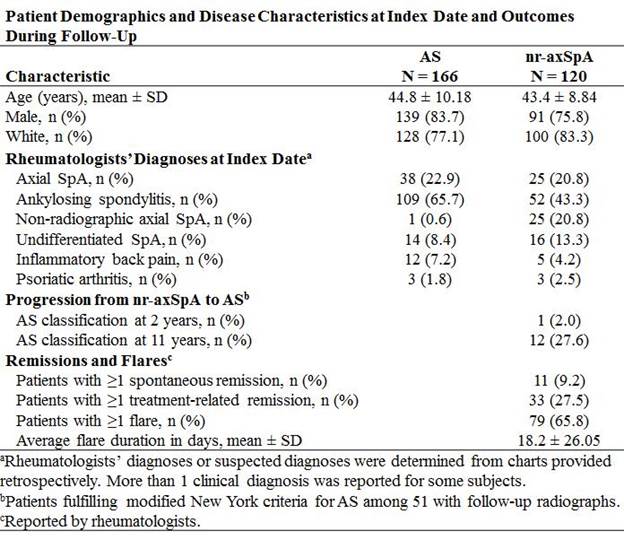Session Information
Session Type: Abstract Submissions (ACR)
Background/Purpose: Limited information is available on progression of non-radiographic axial spondyloarthropathy (nr-axSpA) to ankylosing spondylitis (AS) in patients with SpA meeting the Assessment of Spondyloarthritis International Society (ASAS) criteria in the US. We assessed disease progression from nr-axSpA to AS and numbers of remissions and flares in this population in rheumatology practices.
Methods: SPEED-2 was a retrospective, multicenter, observational cohort study based on medical chart review. For inclusion, individuals met the following criteria (from 2000 to 2005): ≥18 years old; rheumatologists’ diagnoses or suspected diagnoses of SpA (axial SpA, nr-axSpA, AS, or undifferentiated SpA); fulfilled ASAS criteria for axial SpA; with a minimum follow up of ≥7 years with ≥1 documented radiographic assessment of sacroiliac joints (SIJ). An index date was defined as the earliest date between 2000-2005 when subjects had SIJ radiographs after having retrospectively fulfilled ASAS criteria. Their disease course, from 7-12 years following the index date (follow-up period), was reviewed. Stratified analyses included patients with AS and nr-axSpA in an approximate 1:1 ratio. Rate of progression from nr-axSpA to AS over time was determined by Kaplan-Meier analysis according to SIJ radiographs. Number of rheumatologist-reported “remissions” (defined as symptom- and treatment-free periods) and “flares” (defined as periods with increased symptoms requiring treatment during follow-up) were summarized.
Results: Of 286 patients fulfilling ASAS criteria for axial SpA, 166 were classified as AS and 120 as nr-axSpA. Patients with AS or nr-axSpA were predominantly white, male, with a mean age of 45 and 43 years, respectively. Approximately 89% and 85%, respectively, had an original diagnosis of axial SpA, AS, or nr-axSpA. Of 120 patients with nr-axSpA, 51 had a repeat SIJ radiographs during follow-up: approximately 2% of these 51 patients progressed to AS in the first 2 years and 27.6% over a period of 11 years after the index date. The majority of patients with nr-axSpA did not have spontaneous (91%) or treatment-related (73%) remissions reported. During follow-up, 66% with nr-axSpA had ≥1 flare, with an average duration of 18 days, suggesting ongoing disease activity.
Conclusion: This observational cohort study demonstrated that few patients with nr-axSpA progressed to AS. Few spontaneous or treatment related remissions were reported among both nr-axSpA and AS patients, and the majority experienced disease flares during the follow-up period, indicative of disease activity.
Disclosure:
E. Ruderman,
AbbVie,
5;
V. Strand,
Loftis/Strand Consulting Inc., AbbVie,
5;
A. Joshi,
AbbVie,
3,
AbbVie,
1;
Y. Bao,
AbbVie, Inc.,
1,
AbbVie, Inc.,
3;
K. Betts,
Analysis Group, which received payment from AbbVie Inc. to assist with abstract preparation,
3;
P. Chopra,
Analysis Group, which received payment from AbbVie Inc. to assist with abstract preparation,
3;
M. B. McGuire,
Medical Data Analytics, which received funding for data collection,
3;
S. A. Rao,
AbbVie,
1,
AbbVie,
3.
« Back to 2013 ACR/ARHP Annual Meeting
ACR Meeting Abstracts - https://acrabstracts.org/abstract/spondyloarthritis-epidemiology-and-burden-phase-2-speed-2-study-disease-progression-in-axial-spondyloarthropathy-spa/

